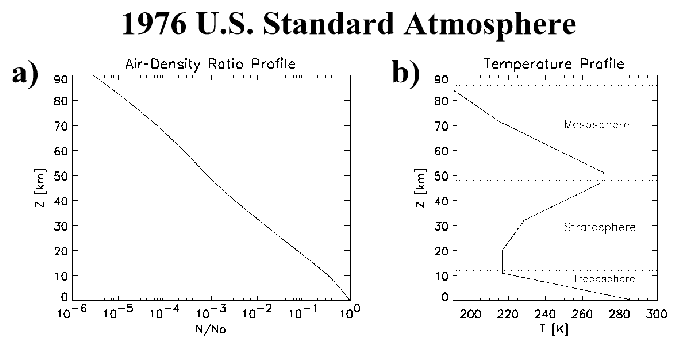In 1953, the United States Committee on Extension to the Standard
Atmosphere (COESA) was formed to assemble information on atmospheric
parameters at altitudes traversed by suborbital rockets. One result
of this effort was a mid-latitude (45![]() N) mean atmospheric
profile published in U.S. Standard Atmosphere, 1962. COESA
provided information, graphs, and tables of the latitudinal, seasonal,
and diurnal variations of atmospheric parameters in U.S. Standard Atmosphere Supplements, 1966. The 1962 U.S. Standard
Atmosphere model was updated when the United States National Oceanic
sand Atmospheric Administration (NOAA) released U.S. Standard
Atmosphere: 1976. The 1976 U.S. Standard Atmosphere is identical to
the 1962 U.S. Standard Atmosphere for altitudes below 50 km, but
differs for higher altitudes.
N) mean atmospheric
profile published in U.S. Standard Atmosphere, 1962. COESA
provided information, graphs, and tables of the latitudinal, seasonal,
and diurnal variations of atmospheric parameters in U.S. Standard Atmosphere Supplements, 1966. The 1962 U.S. Standard
Atmosphere model was updated when the United States National Oceanic
sand Atmospheric Administration (NOAA) released U.S. Standard
Atmosphere: 1976. The 1976 U.S. Standard Atmosphere is identical to
the 1962 U.S. Standard Atmosphere for altitudes below 50 km, but
differs for higher altitudes.
Fortran code for the 1976 U.S. Standard Atmosphere was obtained off
of the web (http://gate.cruzio.com/![]() pdas/atmosf90.htm). The code was converted to Octave and IDL to
interface with conventional breakdown (Section 2.5) and
refraction (Appendix B.5) calculations respectively.
pdas/atmosf90.htm). The code was converted to Octave and IDL to
interface with conventional breakdown (Section 2.5) and
refraction (Appendix B.5) calculations respectively.
A critical atmospheric parameter for conventional breakdown models is
the air number density, ![]() , since the breakdown field,
, since the breakdown field, ![]() , scales
directly with
, scales
directly with ![]() (see Sections 2.2.2 and
2.2.3). The scale factor relative to sea level will
be the ratio of
(see Sections 2.2.2 and
2.2.3). The scale factor relative to sea level will
be the ratio of ![]() to that at sea level,
to that at sea level, ![]() .
Figure 2.3a shows the 1976 U.S. Standard Atmosphere model
of air density ratio as a function of height. The air density
decreases exponentially with height.
.
Figure 2.3a shows the 1976 U.S. Standard Atmosphere model
of air density ratio as a function of height. The air density
decreases exponentially with height.
 |
The 1976 U.S. Standard Atmosphere model of temperature as a function
of altitude is shown in Figure 2.3b. The approximate
altitude range of the troposphere, stratosphere, and mesosphere are
shown on the plot. Each successive layer alternates between
polarities for the vertical temperature gradient. Above ![]() 86 km
altitude, the temperature slope becomes positive again (not shown),
which corresponds with the approximate base of the thermosphere. The
changes in temperature with respect to height produce small
``wiggles'' in the air-density ratio in Figure 2.3a, which
otherwise would be a straight line.
86 km
altitude, the temperature slope becomes positive again (not shown),
which corresponds with the approximate base of the thermosphere. The
changes in temperature with respect to height produce small
``wiggles'' in the air-density ratio in Figure 2.3a, which
otherwise would be a straight line.